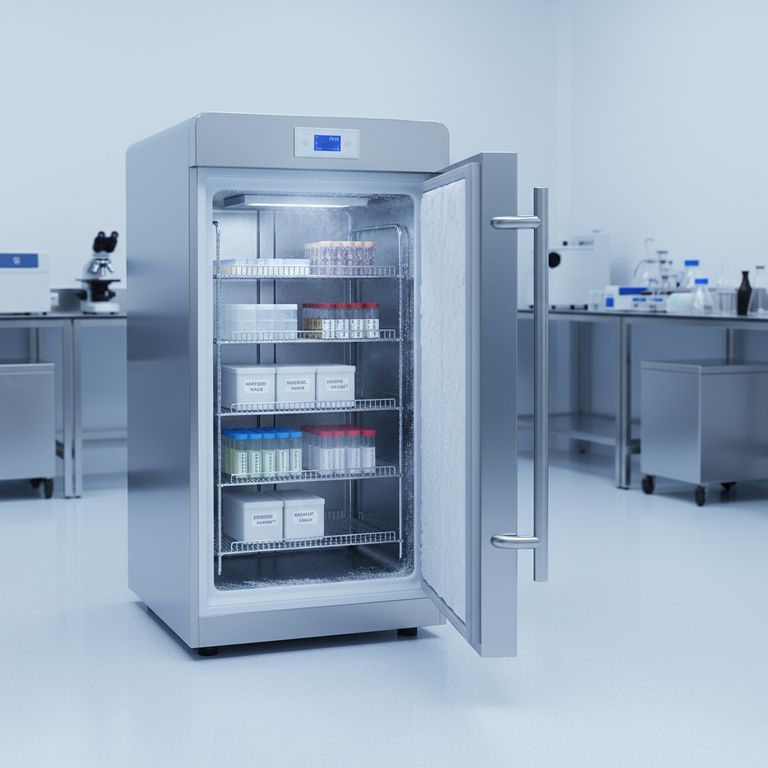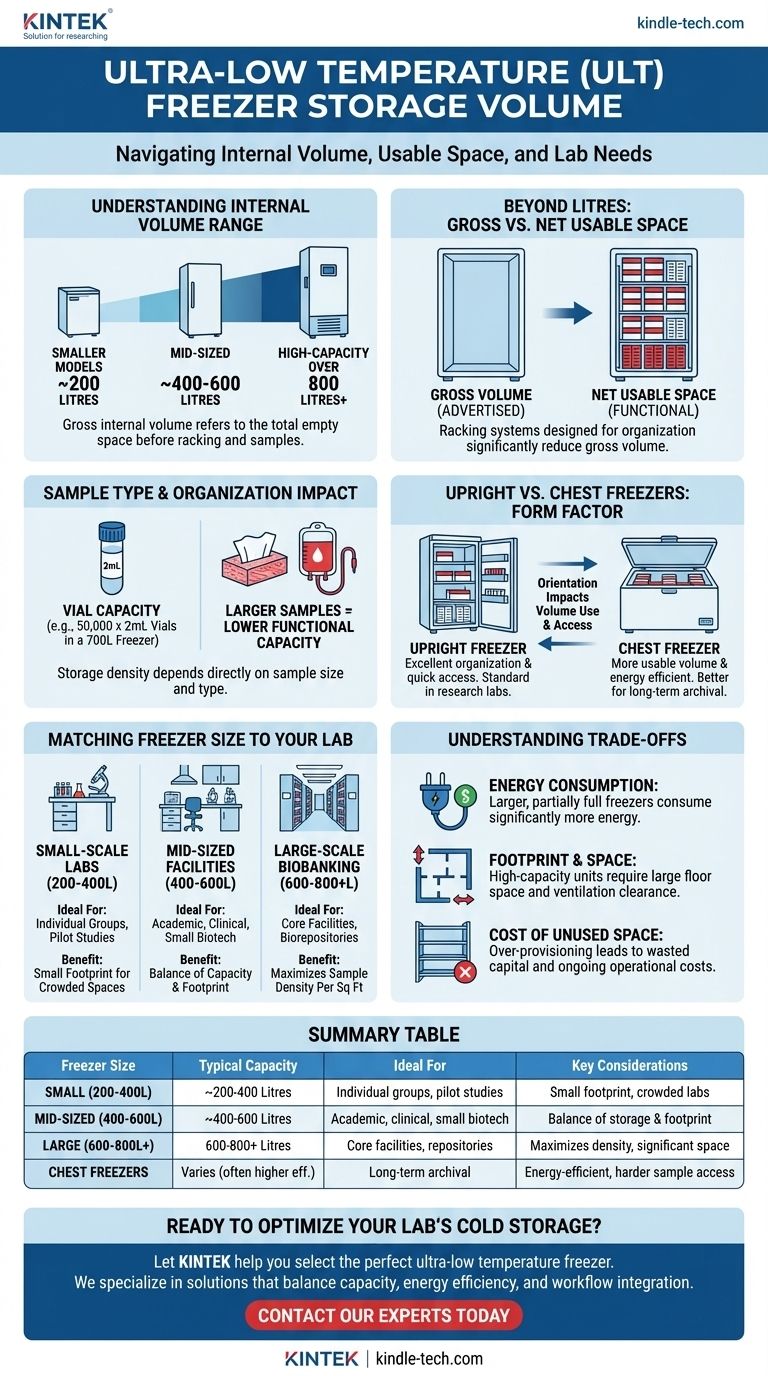In practice, the internal storage volume of a standard ultra-low temperature (ULT) freezer typically ranges from approximately 200 litres on the smaller end to over 800 litres for high-capacity models. This measurement refers to the total empty space inside the freezer chamber before any racks, boxes, or samples are added.
Choosing the right freezer is not a simple question of picking the largest volume you can find. The true challenge is matching the freezer's capacity, form factor, and operational efficiency to your lab's specific workflow, sample types, and future growth plans.

Beyond Litres: Understanding True Storage Capacity
The advertised volume is only the starting point. The actual number of samples a freezer can hold—its functional capacity—is determined by several other critical factors.
From Gross Volume to Net Usable Space
The "litre" specification represents the freezer's gross internal volume. However, effective storage requires organization.
Once you add racking systems designed to hold standard cryo-boxes, the net usable space is always less than the gross volume. A well-designed racking system is essential for maximizing storage density and ensuring easy sample retrieval.
The Impact of Sample Type and Organization
Your storage capacity is directly tied to what you are storing. A freezer's vial capacity is the most common metric.
For example, a 700-litre freezer might hold approximately 50,000 individual 2mL vials. If you are storing larger items like tissue blocks or blood bags, the functional capacity will be significantly lower.
Upright vs. Chest Freezers: A Key Distinction
The physical orientation of the freezer dramatically impacts how you use its volume.
- Upright freezers are the most common type in research labs. They use a system of shelves and vertical racks, offering excellent organization and quick access to specific samples without disturbing others.
- Chest freezers often provide slightly more usable volume for their footprint and are more energy-efficient due to less cold air loss when opened. However, accessing samples at the bottom can be difficult, making them better suited for long-term archival where frequent access is not required.
Matching Freezer Size to Your Application
Selecting the correct size requires a realistic assessment of your current needs and a conservative projection of future growth.
Small-Scale Labs (200-400 Litres)
These smaller units, including under-counter models, are ideal for individual research groups with specific projects, pilot studies, or valuable but low-volume sample collections. Their smaller footprint is a major advantage in crowded lab spaces.
Mid-Sized Facilities (400-600 Litres)
This range is the workhorse for many academic, clinical, and small biotech labs. It provides a healthy balance of storage capacity and physical footprint, accommodating the needs of several small research groups or one large one.
Large-Scale Biobanking (600-800+ Litres)
These high-capacity units are designed for core facilities, clinical trial repositories, and large-scale biorepositories. In these settings, the primary goal is maximizing sample density per square foot of lab space.
Understanding the Trade-offs
A larger freezer is not inherently better. The decision involves balancing capacity with significant operational costs and physical constraints.
Energy Consumption vs. Size
A ULT freezer is one of the most energy-intensive pieces of equipment in a lab. A larger freezer, especially one that is only partially full, consumes a tremendous amount of energy simply to maintain its temperature. It is far more efficient to run one full freezer than two half-empty ones.
Footprint and Lab Space
Floor space is a premium resource in any laboratory. A high-capacity freezer not only occupies a large footprint but also requires significant clearance around it for ventilation (typically 15-20 cm on all sides), further increasing its spatial demand.
The Cost of Unused Space
Over-provisioning a freezer "just in case" leads to wasted capital on the initial purchase and significant ongoing operational costs in electricity and cooling. A better strategy is to plan for growth in stages or choose a model from a manufacturer with a reputation for long-term reliability.
Making the Right Choice for Your Goal
Base your decision on a clear-eyed assessment of your primary storage objective.
- If your primary focus is maximizing sample density in a large facility: Prioritize large-capacity (700-800L) upright freezers and invest in a high-quality, perfectly matched racking system.
- If your primary focus is flexibility for a small, growing lab: Consider a mid-range (400-600L) upright model that balances immediate capacity needs with a manageable energy and spatial footprint.
- If your primary focus is long-term archival with maximum energy efficiency: A chest freezer is often the most cost-effective solution, provided you have a robust inventory management system to track its contents.
By evaluating your workflow and space before focusing on volume, you can select a freezer that becomes a strategic asset for your work.
Summary Table:
| Freezer Size | Typical Capacity | Ideal For | Key Considerations |
|---|---|---|---|
| Small (200-400L) | ~200-400 Litres | Individual research groups, pilot studies | Small footprint, suitable for crowded labs |
| Mid-Sized (400-600L) | ~400-600 Litres | Academic, clinical, and small biotech labs | Balance of storage capacity and physical footprint |
| Large (600-800L+) | 600-800+ Litres | Core facilities, clinical trial repositories | Maximizes sample density, requires significant space |
| Chest Freezers | Varies (often higher efficiency) | Long-term archival storage | Energy-efficient, but harder sample access |
Ready to optimize your lab's cold storage? Let KINTEK help you select the perfect ultra-low temperature freezer for your specific needs. We specialize in lab equipment and consumables, offering solutions that balance capacity, energy efficiency, and workflow integration.
Contact our experts today for a personalized consultation and ensure your lab is equipped for success!
Visual Guide

Related Products
- 158L Precision Vertical Ultra Low Freezer for Laboratory Applications
- 28L Compact Upright Ultra Low Temperature Freezer for Laboratory
- 508L Advanced Vertical Ultra Low Temperature Freezer for Critical Laboratory Storage
- 938L Vertical Ultra Low Temperature Freezer for Advanced Laboratory Storage
- 108L Vertical Ultra Low Temperature ULT Freezer
People Also Ask
- What makes Ultra-Low Temperature freezers energy efficient? Key Design & Operational Strategies
- What features do ultra-low temperature freezers typically include? Ensuring Absolute Sample Security
- What are ultra-low temperature freezers designed for? Preserving Your Most Valuable Biological Samples
- What are the common applications of ultra-low temperature freezers? Preserve Your Most Valuable Samples
- What advantages do ultra-low temperature freezers offer? Ensure Long-Term Sample Integrity and Reliability



















